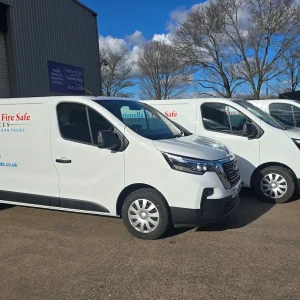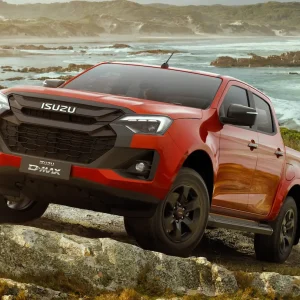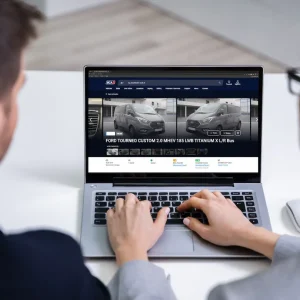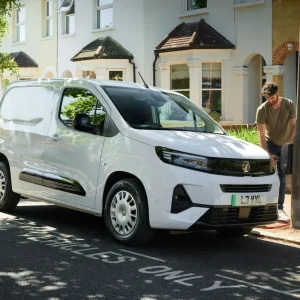 Now on sale, the latest version of Crafter is equipped with BlueTDI engines that comply with the tough new Euro 5 exhaust emission regulations. They have also allowed the newcomer to achieve certification as an Enhanced Environmentally-friendly Vehicle. Grossing at from 3.0 to 5.0 tonnes, the new Crafter does, however, requires periodic topping up with AdBlue, a mixture of urea and water that’s injected into the exhaust gases to help clean them up. Well-known to heavy truck operators, it’s something that is utterly unfamiliar to the majority of van owners. Are you anticipating an adverse reaction to this approach to reducing emissions?
Now on sale, the latest version of Crafter is equipped with BlueTDI engines that comply with the tough new Euro 5 exhaust emission regulations. They have also allowed the newcomer to achieve certification as an Enhanced Environmentally-friendly Vehicle. Grossing at from 3.0 to 5.0 tonnes, the new Crafter does, however, requires periodic topping up with AdBlue, a mixture of urea and water that’s injected into the exhaust gases to help clean them up. Well-known to heavy truck operators, it’s something that is utterly unfamiliar to the majority of van owners. Are you anticipating an adverse reaction to this approach to reducing emissions?
If you add any complexity to a product, in other words if you ask the operator to do something that he’s not doing at present, then this can of course be a potential barrier to its acceptance. The reality though is that topping up your AdBlue is just like topping up your screenwash. What’s more, we’re providing free top-ups for the first three years through our dealer network. Remember that as well as offering cleaner emissions, the BlueTDI engines also boast better fuel consumption than their predecessors. For example, the official Extra Urban fuel consumption for a 109hp engine in a Crafter CR35 van has improved by over seven per cent, from 32.1mpg to 34.4mpg. It’s also worth noting that any Euro 5 Crafter registered before the end of this year will qualify for lower road tax for the lifetime of the vehicle. At present that saves you £60 annually.
 How many Crafters do you expect to sell this year?
How many Crafters do you expect to sell this year?
Including both the old Euro 4 and the new Euro 5 models, we should sell 3,150. Next year we should sell slightly more.
What’s the sales split between Crafter vans and chassis cabs?
Vans make up around 80 per cent of our volume but we intend to concentrate more on promoting our range of chassis cab conversions. Over the past few years we’ve seen constant growth across our range — growth in sales, growth in profits and so on — so we’ve not really tried to exploit to the full some of the great products we’ve got. Our Engineered to Go range of Crafter-based tippers, dropsides and Lutons is a good example of what I mean. They’ve not been promoted fully. So what we’ve now got to do is take a closer look at the opportunities they offer. We’ve got to bring them out of the shadows.
What’s prompted you to provide a three year/unlimited mileage warranty with Crafter?
Sprinter already has the same sort of warranty and Crafter is made in the same factory.
 Both vehicles do of course share a number of components. Turning to other models in the VW range, how soon before the new, purpose-built, Mitsubishi L200/Ford Ranger rivalling Amarok pick-up is launched in the UK?
Both vehicles do of course share a number of components. Turning to other models in the VW range, how soon before the new, purpose-built, Mitsubishi L200/Ford Ranger rivalling Amarok pick-up is launched in the UK?
It will be here in September 2010 — hopefully on the first of that month — with double cab models equipped with the bigger-output diesel engines in the range arriving first. We’ll be stepping into the pick-up market gradually though. We’re not getting carried away with massive ambitions for big sales volumes and a big market share; in fact we’ve set our aspirations very low. Remember that double cab pick-ups benefit from a tax loophole (so far as personal tax and VAT reclamation are concerned they’re treated as commercial vehicles rather than cars – SB) that could of course be closed and that many of them are sold to builders who don’t at present have a lot of disposable income. If our softly-softly approach means that we end up with a product that’s in great demand, then that gives us something to build on. If on the other hand we end up bringing in too many on day one, then that will be a disaster.
 When do we see the new Transporter in Britain?
When do we see the new Transporter in Britain?
It probably won’t be launched until early 2010. It’s been heavily face-lifted and although the front-end takes some design cues from the current Golf, it’s still clearly a Transporter. The existing Transporter remains in demand and we should sell 12,000 this year. Volumes next year for its successor should be about the same.
How well are Caddy and Caddy Maxi doing?
Caddy has felt a little bit of pressure from models such as Citroën’s Nemo and Peugeot’s Bipper, but it’s doing well nevertheless and its residual values are excellent. We should sell about 7,000 in 2010, which will be up on this year. Earlier this year we announced an order for 5,300 Caddy Vans from British Gas; our biggest-ever fleet deal. Maxi accounts for around 10 per cent of total Caddy sales and that’s a percentage we’d like to increase. I think it will because there is a trend for people to downsize from larger models.
Including Transporter in this case?
Yes, and that’s why it’s so important that we identify trends in the market early on. There’s no point in having too many examples of a particular model in stock if they’re no longer wanted. I also think incidentally that we’ll see more Caddy and Caddy Maxi vans sold with the semi-automatic Direct Shift Gearbox.
Are you continuing with the well-equipped, upmarket, Sportline derivatives of certain models?
We are and it’s an area of activity we intend to expand. We’ve just introduced a limited edition Sportline version of Transporter called the Sportline X. We thought we’d order 50 from the factory and see how they went. Within a day, however, we received 70 orders from the network so we’ve decided to order 150. They’ll sell because there’s a demand for this type of vehicle even in the current economic climate.
 There’s also a demand from some operators for vans that will run on environmentally-friendly alternative fuels. How are you setting about satisfying it?
There’s also a demand from some operators for vans that will run on environmentally-friendly alternative fuels. How are you setting about satisfying it?
We’ve got a Caddy that will run on compressed natural gas. We’ll sell a small number this year — hopefully around 25 — but we’ve received a lot of positive interest from several operators going forward. If they bear fruit we could sell 200 in 2010; maybe more. There’s a possibility that we’ll be launching an electric Caddy too although that’s unlikely to arrive until 2014. We’ll also be bringing in BlueMotion versions of Caddy and Transporter during the next few months. (BlueMotion involves, for example, linking the engine to longer gear ratios to cut revs and improve fuel economy; the sort of technology that’s already being deployed in the new Euro 5 Crafter – SB).
Have you been tempted to offer big discounts to keep registrations buoyant given the tough economic climate?
No. The result is that our residual values have stayed healthy — the existing Transporter is a case in point — and that has helped keep our contract hire rates competitive. As a consequence a high percentage of our customers are now acquiring vehicles on contract hire agreements. Over 50 per cent of the deals we’re doing at the moment are funded through Volkswagen Commercial Vehicle Finance and of those, probably 70 per cent are contract hire. Unlike certain other organisations we’ve got access to funds and our policy of protecting our residuals is clearly working for us. For several months this year we’ve been the number two player in the van market, ahead of manufacturers such as Vauxhall, Citroën and Mercedes. Obviously the strength of our product line-up has had a huge influence too and so has our dedicated van centre network.
 Why is having a van network that isn’t run as some sort of annex to a manufacturer’s passenger car business so important?
Why is having a van network that isn’t run as some sort of annex to a manufacturer’s passenger car business so important?
If you’re a dealer whose main activity is selling cars then where’s your focus going to be? The fact that our dealers are totally dedicated to vans means that they can concentrate on them completely, without having to deal with any distractions. They learn how the van customer ticks, they get to understand the relevant legislation and what the tax rules are and they gain an in-depth knowledge of the different types of finance package that are likely to meet the van owner’s needs. They can also explain why some models may require AdBlue, and what AdBlue is. They are not constantly looking over their shoulders to see if a car buyer is about to walk into the showroom. Something else we’re doing is making sure that we’re not saddled with excess stock. Too much stock is death for a manufacturer because you end up distress-selling. That’s no good for the customers because, again, it destroys residuals, so tight stock management is high on the list of things we focus on.
How many dealers have you got?
We’ve got 63 full van centres offering sales, service and parts and the majority of them are in stand-alone facilities. On top of that we’ve got 18 authorised repairers. As it happens we filled our key open points in the last few weeks. Greenhous is now our dealer in Shrewsbury, Imperial is moving into Derby and Nottingham for us while Benfield is representing us on Teeside. As things stand, though, we’re not looking to expand the van centre network any further because each centre has to be viable and be in a position to invest and make a profit. That said, we have got land in Liverpool where we plan to build a dealership when the time is right. We’ll act as landlords but a dealer will run the business.
I guess the right time will be when the van market shows signs of recovering from the recession. How soon before we see indications of a sustained improvement?
Not before well into 2010.
What impact has the much-publicised government-backed scrappage scheme had on VW light commercial sales?
Not much. So far we’ve only sold 80 as a result of the scheme. It’s been of very little consequence.





